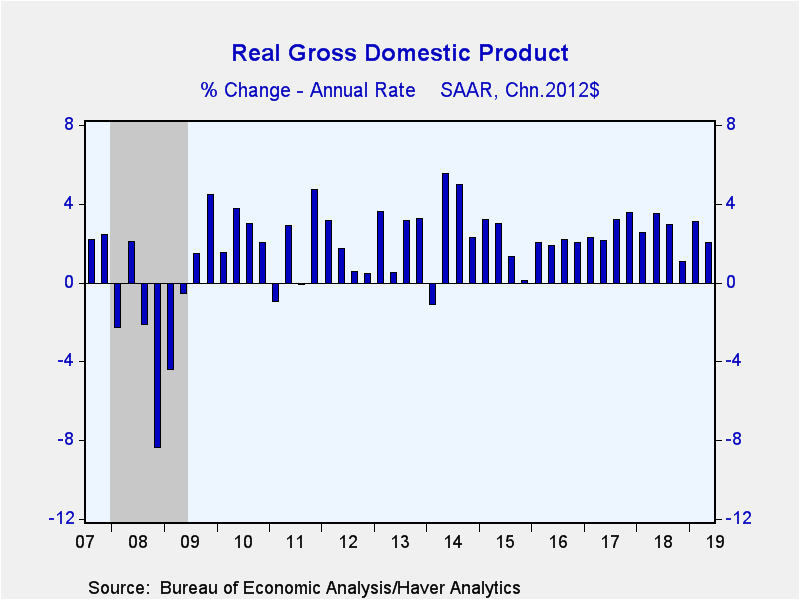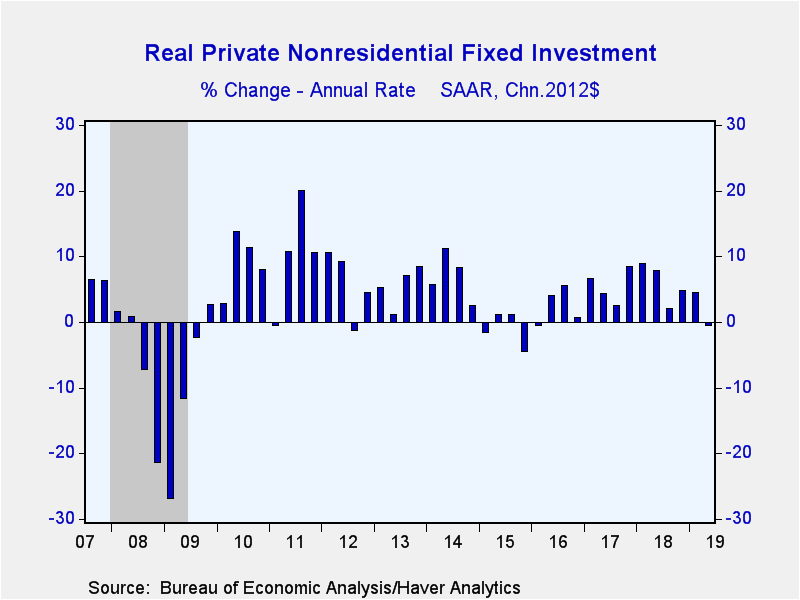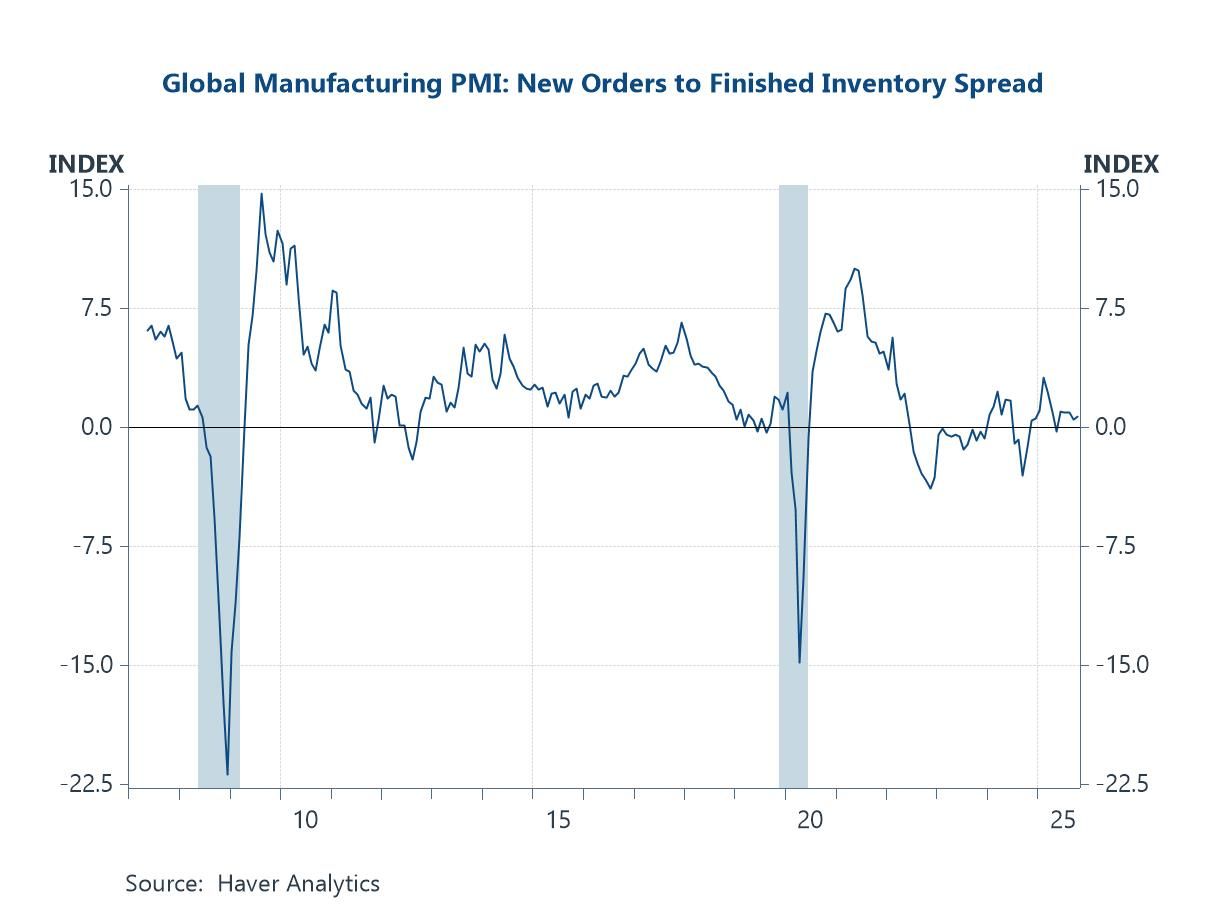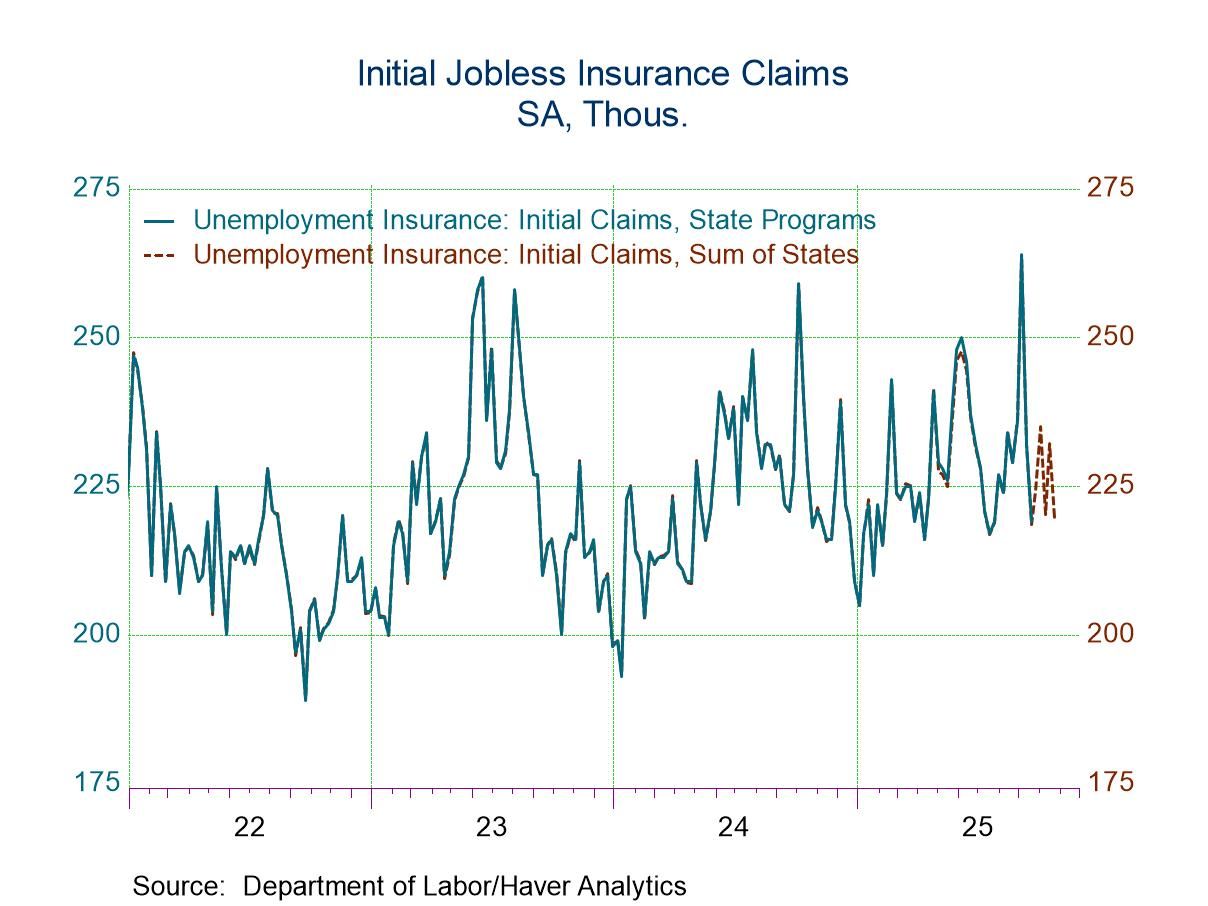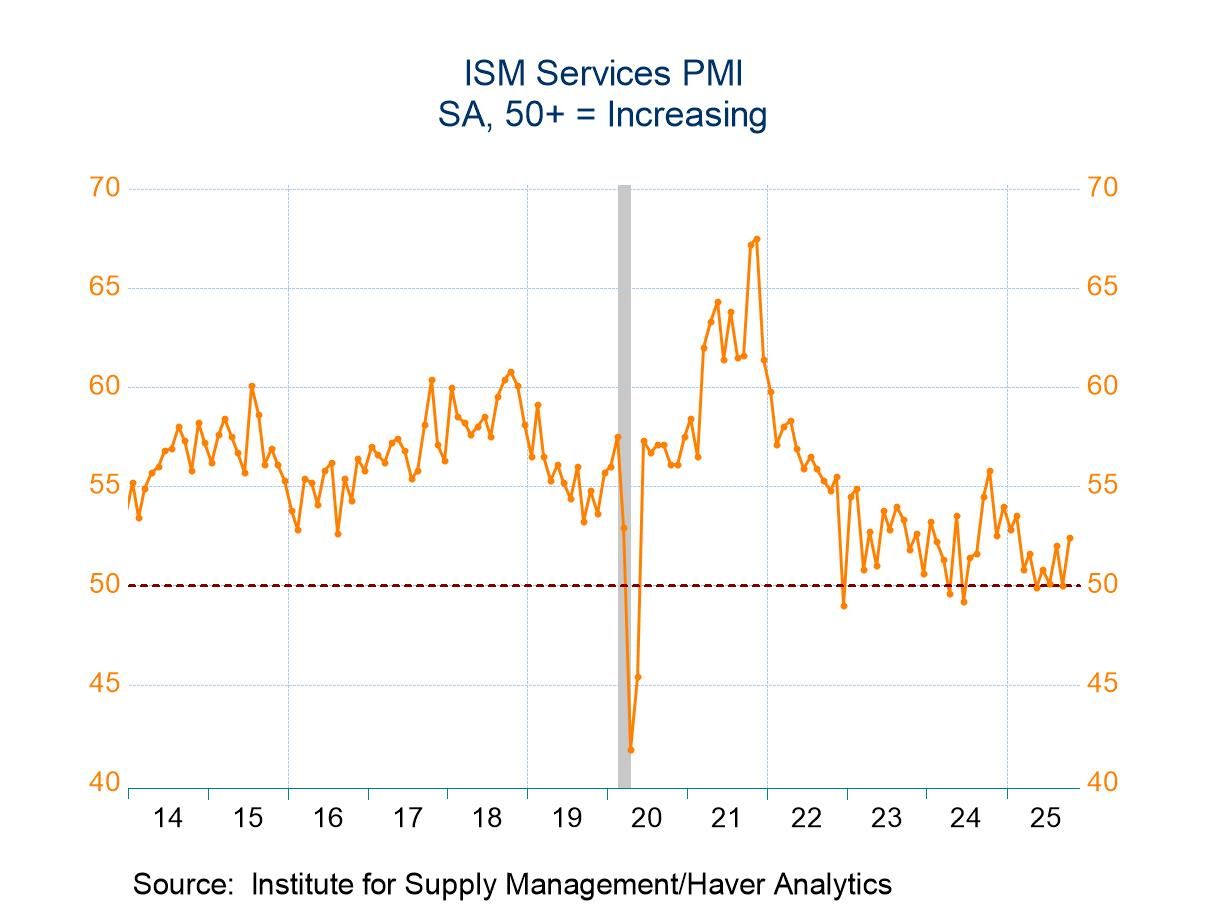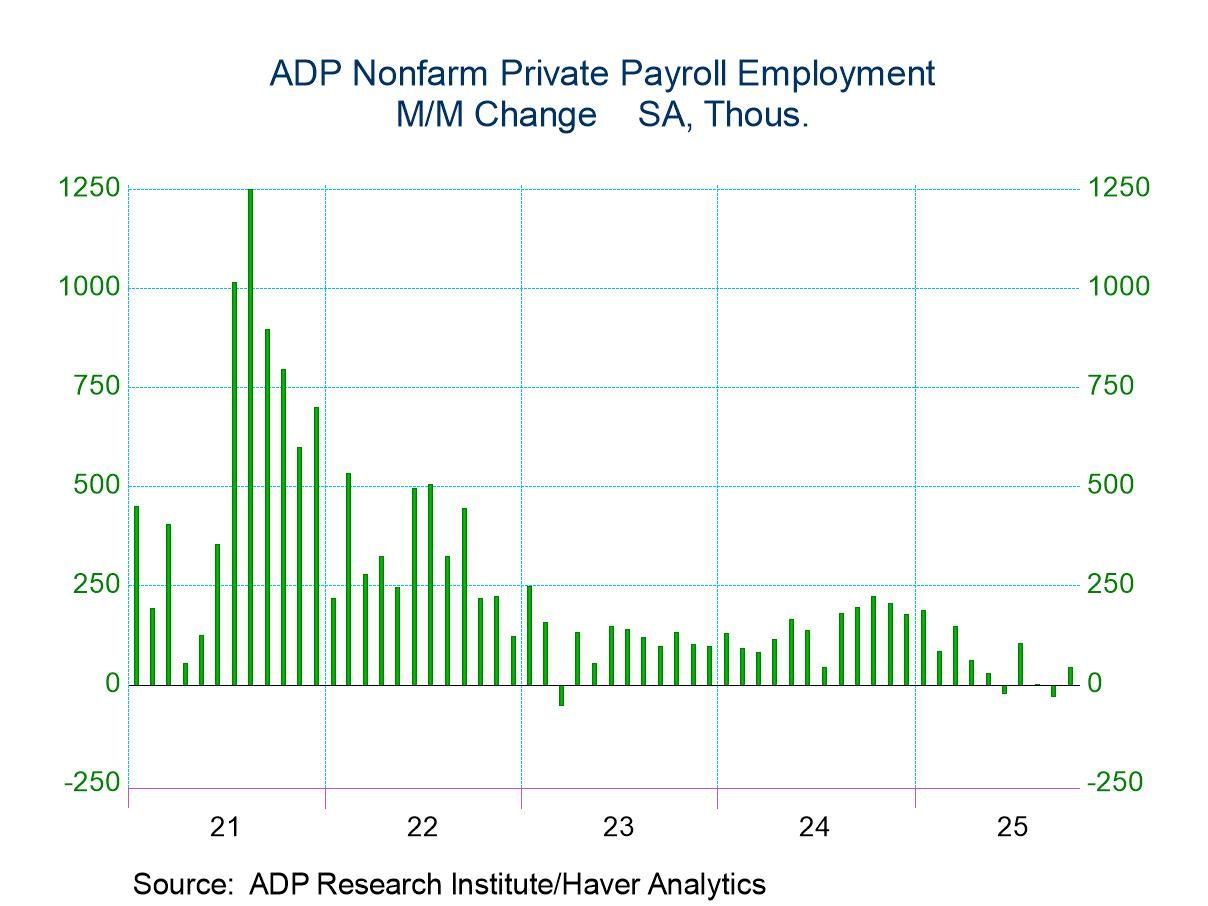 Global| Jul 26 2019
Global| Jul 26 2019U.S. GDP Growth Eases
by:Tom Moeller
|in:Economy in Brief
Summary
Economic growth slowed last quarter, but not as much as expected. Real GDP increased 2.1% (AR) in Q2'19 (2.3% y/y) following an unrevised 3.1% increase during Q1. A 1.8% gain had been expected in the Action Economics Forecast Survey. [...]
Economic growth slowed last quarter, but not as much as expected. Real GDP increased 2.1% (AR) in Q2'19 (2.3% y/y) following an unrevised 3.1% increase during Q1. A 1.8% gain had been expected in the Action Economics Forecast Survey. Data back for five years was revised.
Growth in domestic final sales continued to drive the economy forward with a 3.5% increase (2.3% y/y). It was the largest quarterly gain in a year, underpinned by a 4.3% advance (2.6% y/y) in personal consumption expenditures. That was the strongest quarterly rise since Q4'17 and driven by a 12.9% strengthening (4.4% y/y) in durable goods purchases. Growth was bolstered by a 17.0% advance (9.3% y/y) in purchases of recreation goods & vehicles which came after 12.5% Q1 growth. Spending on motor vehicles improved 15.9% (1.8% y/y) and reversed the Q1 decline. Spending of home furnishings & appliances grew 9.1% (2.7% y/y) after a 1.9% rise. Spending on nondurable goods rose 6.0% (3.4% y/y), the strongest quarterly gain in over 25 years. It was led by a 14.1% jump (4.4% y/y) in clothing outlays. Food & beverage spending gained an improved 5.1% (1.8% y/y), but spending on gasoline & other energy products rose just 0.7% (0.1% y/y). Consumer outlays on services gained 2.5% (2.1% y/y), the strongest growth in three quarters. Spending at restaurants & hotels increased 4.6% (2.0% y/y) following two quarters of decline. Recreation spending improved 3.9% (1.7% y/y) after a moderate fall. Health care outlays rose 2.8% (3.1% y/y), weakening after a 6.5% rise. Housing & utilities spending rose 1.1% and by a weakened 0.7% y/y. Transportation spending rose a negligible 0.7% (-0.1% y/y).
Stronger government spending also propped up domestic final sales growth with a 5.0% increase (2.4% y/y) which followed a 2.9% rise. Combined, these were the strongest gains in ten years. Federal government outlays jumped a strengthened 7.9% (3.5% y/y) as nondefense outlays surged 15.9% (1.8% y/y) and made up two straight quarters of decline. Defense outlay growth moderated to 2.8%. Growth of 4.6% y/y was up, however, from declines from 2011 to 2016. Spending by state & local governments also picked up to 3.3% in 2019 from minimal growth two years earlier.
In other categories, final demand declined last quarter. Nonresidential fixed investment eased 0.6% (+2.7% y/y) after two years of strong gain. Spending on structures declined 10.5% (-4.6% y/y). Investment in equipment rose 0.7% (2.7% y/y) following stability in Q1. Spending on information processing equipment improved 6.7% (6.1% y/y) but spending on transportation & equipment fell 9.2% (+0.1% y/y), off for the fourth quarter in the last five. Intellectual property product spending improved 4.6% (7.8% y/y), down from 7.4% growth last year. Residential investment fell 1.5% (-2.8% y/y) and has been falling since late in 2017.
The effects on GDP growth from inventories and foreign trade turned negative last quarter. Inventories subtracted 0.9 percentage points from GDP growth and reversed additions during the prior two quarters. Deterioration in net exports subtracted 0.7 percentage points from GDP growth and reversed the Q1 addition. Exports declined 5.2% (-1.5% y/y), after moving sideways since late-2017. Imports inched 0.1% higher (2.6% y/y), after moving moderately lower versus a Q4'18 peak.
Price inflation picked up last quarter. The GDP chain price index rose at a 2.4% annual rate (1.8% y/y), the quickest growth in four quarters. The PCE chain price index surged 2.3% (1.4% y/y) after rising 0.4% in Q1. Higher food & beverage prices, as well as costlier clothing and home furnishings, accounted for the acceleration. The business fixed investment price index rose 2.0% (1.3% y/y), the quickest growth in eight years. The gain in the structures price index was a steady 4.2%, and the equipment price index rose slightly (0.4% y/y). The intellectual & property product price index surged 2.8% (0.6% y/y). The increase in the residential price index moderated to 2.6% y/y from 5.6% just last year.
The GDP figures can be found in Haver's USECON and USNA database. USNA contains virtually all of the Bureau of Economic Analysis' detail in the national accounts. Both databases include tables of the newly published not seasonally adjusted data. The Action Economics consensus estimates can be found in AS1REPNA.
| Chained 2012 $ (%, AR) | Q2'19 (Advance Estimate) | Q1'19 | Q4'18 | Q2'19 Y/Y | 2018 | 2017 | 2016 |
|---|---|---|---|---|---|---|---|
| Gross Domestic Product | 2.1 | 3.1 | 1.1 | 2.3 | 2.9 | 2.4 | 1.9 |
| Inventory Effect (%-point) | -0.9 | 0.5 | 0.1 | 0.5 | 0.1 | 0.1 | -0.3 |
| Final Sales | 3.0 | 2.6 | 1.0 | 1.8 | 2.8 | 2.3 | 2.2 |
| Foreign Trade Effect (%-point) | -0.7 | 0.7 | -0.4 | 0.5 | -0.2 | -0.2 | -0.2 |
| Domestic Final Sales | 3.5 | 1.8 | 1.3 | 2.3 | 3.0 | 2.5 | 2.4 |
| Personal Consumption Expenditure | 4.3 | 1.1 | 1.4 | 2.6 | 3.0 | 2.6 | 2.7 |
| Nonresidential Fixed Investment | -0.6 | 4.4 | 4.8 | 2.7 | 6.4 | 4.4 | 0.7 |
| Residential Investment | -1.5 | -1.1 | -4.6 | -2.8 | -1.5 | 3.5 | 6.5 |
| Government Spending | 5.0 | 2.9 | -0.4 | 2.4 | 1.7 | 0.7 | 1.8 |
| Chain-Type Price Index | |||||||
| GDP | 2.4 | 1.1 | 1.6 | 1.8 | 2.4 | 1.9 | 1.0 |
| Personal Consumption Expenditure | 2.3 | 0.4 | 1.3 | 1.4 | 2.1 | 1.8 | 1.0 |
| Less Food & Energy | 1.8 | 1.1 | 1.7 | 1.5 | 1.9 | 1.6 | 1.6 |
| Nonresidential Investment | 2.0 | 1.6 | -0.0 | 1.3 | 1.4 | 1.0 | -0.9 |
| Residential Investment | 1.4 | 2.6 | 2.5 | 2.6 | 5.6 | 4.5 | 3.5 |
Tom Moeller
AuthorMore in Author Profile »Prior to joining Haver Analytics in 2000, Mr. Moeller worked as the Economist at Chancellor Capital Management from 1985 to 1999. There, he developed comprehensive economic forecasts and interpreted economic data for equity and fixed income portfolio managers. Also at Chancellor, Mr. Moeller worked as an equity analyst and was responsible for researching and rating companies in the economically sensitive automobile and housing industries for investment in Chancellor’s equity portfolio. Prior to joining Chancellor, Mr. Moeller was an Economist at Citibank from 1979 to 1984. He also analyzed pricing behavior in the metals industry for the Council on Wage and Price Stability in Washington, D.C. In 1999, Mr. Moeller received the award for most accurate forecast from the Forecasters' Club of New York. From 1990 to 1992 he was President of the New York Association for Business Economists. Mr. Moeller earned an M.B.A. in Finance from Fordham University, where he graduated in 1987. He holds a Bachelor of Arts in Economics from George Washington University.


